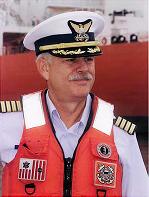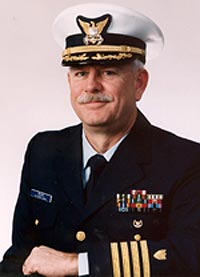From Contemporary Press Reports:
Rear Adm. Richard Bennis, who directed the Coast Guard evacuation of Manhattan after 9/11, spent his last days in Stafford County.
USCG Photo
Dick Bennis never wondered why he had brain cancer; after the terrorist attacks on 9/11, he told a friend he knew exactly why he had gotten ill.
His failing health had kept him in New York City, directing the activities in the harbor, at the one moment his nation needed him the most.
After the World Trade Center collapsed, the Coast Guard led an effort to get half a million people out of Manhattan by water. Officers organized a volunteer flotilla–a motley crew of ferries, pleasure boats and any other vessels they could get their hands on–to get panicked people off the island and to other boroughs.
As captain of the Port of New York, Bennis directed that effort.
Now, he’s being remembered as the unsung hero of the impressive evacuation.
Rear Adm. Richard E. Bennis, 53, died August 3, 2003, at Mary Washington Hospital after a four-year battle with cancer.
He had moved to Stafford County in 2002 to take a post with the new Transportation Security Administration. He was chief of maritime and land security for the new agency, which is under the Homeland Security Department.
Bennis worked right up until the end. He was calling people and sending e-mails on Friday, two days before his death, said Pat Harris, a Stafford resident who worked with Bennis in New York, then followed him to Washington.
“If you picked up the phone and called him, you would never have known that he was sick,” Harris said. “He had the same sense of humor, same clarity.
“Everybody expected to see Dick Bennis look like he was going to die, but he never looked like that, never.”
Not even after doctors cut into his skull to try to remove the cancer, Harris said.
Bennis had the first of two operations on his brain a week before the terrorist attacks. He had the staples taken out of his head September 10, 2001.
The next day, he and his wife, Gloria, headed to Florida to look for a place to retire. They were near Quantico when Harris, who was second in command at the New York port, called Bennis and told him to find a television.
The Bennises watched as the second plane crashed into the World Trade Center, then headed back north. From the interstate, they could see fires burning at the Pentagon.
The Admiral got onto a boat at Sandy Hook, New Jersey, and headed into the New York harbor.
All along the way, he’d been in touch with Harris, going over the plans and giving guidance.
That was the way Bennis operated. He gave people responsibilities and trusted them to do their jobs.
“He was a great man to work for,” said Lieutenant Commander Christopher Nichols, a Pennsylvania man who now works at Coast Guard headquarters in Washington.
Nichols was working in New York on 9/11, and said the Coast Guard performed so well then–and in establishing new security provisions afterward–because of Bennis’ leadership style.
“I’ve worked for people in the past, and I couldn’t take a breath without getting permission,” Nichols said. “The admiral was the antithesis of the micromanager. In his standing orders to us, he told us, ‘If you can’t get hold of me, and you think it’s in your best judgment, you act first.'”
Many things Bennis learned during his 30 years in the Coast Guard were put into action after 9/11, Harris said. The year before, the admiral had organized an event called Operation Sail 2000, in which 70,000 boats entered the New York harbor for an Independence Day festival.
Bennis and other Coast Guard officials had to plan for all kinds of contingencies for that event, which also included an appearance by the president. They drew up plans for the evacuation of Manhattan–in case of a disaster–and where they’d place triage sites.
When 9/11 occurred, the Coast Guard “went through all of the old plans.”
That’s why Bennis thought his cancer “was meant to be,” Harris said.
“Everything we ever learned, we used that day and in the six weeks after it,” he said.
Bennis’ health seemed to improve by March 2002, when he moved to the Fredericksburg area for a new job. He took half a dozen Coast Guard officials, including Harris, with him to develop strategies to protect the nation’s rails and roads, pipelines and waterways from other attacks.
Bennis had worked in the Washington area three times, and always lived in Stafford County.
“He loved the area,” Harris said. “He got us excited about moving down here and told me, ‘Make sure you live near the VRE [Virginia Railway Express].'”
Other Coast Guard members in the region also remember the Admiral fondly. About 2,000 people work at the headquarters in Washington, and many make their homes in the Fredericksburg area, said Ron Northrup, a Coast Guard Lieutenant Commander.
“I’m just sorry we lost a great man,” he said. “Admiral Bennis was very well liked, and he led a great effort in New York. He really had an impact on everyone in this country, I believe.”
The Bennis family has planned a memorial service in New York on Friday. There will also be a service with full military honors in Arlington National Cemetery on September 23, 2003.
Adm. Bennis was born in Syracuse, New York, and grew up in Rhode Island. He graduated from the University of Rhode Island in 1972 and began his career in the Coast Guard, where he served as captain of the port in Charleston, South Carolina, and in Hampton Roads.
His awards included the Transportation Department distinguished service medal, three secretary of transportation gold medal awards, four Coast Guard meritorious service medals, three Coast Guard commendation medals and the Navy/Marine Corps commendation medal.
Survivors include his wife, Gloria, whom he married in 1968, of Stafford; three children, Keith Bennis of Mount Pleasant, S.C., Timothy Bennis of Staten Island, N.Y., and Wendy Westberry of Columbia, S.C.; his mother, Winifred Bennis of Wyoming, R.I.; a sister; and a grandson.
Rear Admiral Richard Bennis Dies; TSA Official
Richard E. Bennis, 53, a retired Coast Guard rear admiral who since March 2002 had been chief of maritime and land security for the new Transportation Security Administration, died August 3, 2003, at Mary Washington Hospital in Fredericksburg. He had suffered from melanoma for four years.
Adm. Bennis was captain of the port of New York and New Jersey on September 11, 2001, and in that capacity organized the evacuation of nearly 500,000 people from lower Manhattan after the terrorist attacks on the World Trade Center.
He retired from the Coast Guard in 2002 and was subsequently named associate undersecretary for maritime and land security for the Transportation Security Administration. This involved security provision for the maritime, rail, highway, mass transit and pipeline modes of the National Transportation System.
Adm. Bennis, a resident of Stafford County, was born in Syracuse, New York, and grew up in Rhode Island.
He graduated from the University of Rhode Island in 1972 and began a career in the Coast Guard, where he served in marine safety and environmental protection programs and as captain of the port in Charleston, South Carolina, and Hampton Roads, Virginia. While serving in the Coast Guard, he received a master’s degree in energy and environmental science at Harvard University.
From 1995 to 1997, he was chief of the Coast Guard’s office of response to emergencies ranging from search and rescue to oil spills.
As captain of the port of New York and New Jersey, Admiral Bennis led the largest operational field command in the Coast Guard and was responsible for all Coast Guard missions from Sandy Hook, New Jersey, to Canada.
In the period after September 11, 2001, he organized a volunteer fleet of more than 100 boats to evacuate lower Manhattan, and he led a round-the-clock effort that noticeably increased the Coast Guard presence in New York Harbor.
His awards included the Transportation Department Distinguished Service Medal, three Secretary of Transportation Gold Medal awards, four Coast Guard Meritorious Service Medals, three Coast Guard Commendation Medals and the Navy/Marine Corps Commendation Medal.
Survivors include his wife, Gloria, whom he married in 1968, of Stafford; three children, Keith Bennis of Mount Pleasant, S.C., Timothy Bennis of Staten Island, N.Y., and Wendy Westberry of Columbia, S.C.; his mother, Winifred Bennis of Wyoming, R.I.; a sister; and a grandson.
Rear Admiral Richard Bennis Dies; TSA Official
Richard E. Bennis, 53, a retired Coast Guard Rear Admiral who since March 2002 had been chief of maritime and land security for the new Transportation Security Administration, died August 3, 2003, at Mary Washington Hospital in Fredericksburg. He had suffered from melanoma for four years.
Adm. Bennis was captain of the port of New York and New Jersey on September 11, 2001, and in that capacity organized the evacuation of nearly 500,000 people from lower Manhattan after the terrorist attacks on the World Trade Center.
He retired from the Coast Guard in 2002 and was subsequently named associate undersecretary for maritime and land security for the Transportation Security Administration. This involved security provision for the maritime, rail, highway, mass transit and pipeline modes of the National Transportation System.
Adm. Bennis, a resident of Stafford County, was born in Syracuse, N.Y., and grew up in Rhode Island.
He graduated from the University of Rhode Island in 1972 and began a career in the Coast Guard, where he served in marine safety and environmental protection programs and as captain of the port in Charleston, S.C., and Hampton Roads, Va. While serving in the Coast Guard, he received a master’s degree in energy and environmental science at Harvard University.
From 1995 to 1997, he was chief of the Coast Guard’s office of response to emergencies ranging from search and rescue to oil spills.
As captain of the port of New York and New Jersey, Admiral Bennis led the largest operational field command in the Coast Guard and was responsible for all Coast Guard missions from Sandy Hook, N.J., to Canada.
In the period after September 11, 2001, he organized a volunteer fleet of more than 100 boats to evacuate lower Manhattan, and he led a round-the-clock effort that noticeably increased the Coast Guard presence in New York Harbor.
His awards included the Transportation Department Distinguished Service Medal, three Secretary of Transportation Gold Medal awards, four Coast Guard Meritorious Service Medals, three Coast Guard Commendation Medals and the Navy/Marine Corps Commendation Medal.
Survivors include his wife, Gloria, whom he married in 1968, of Stafford; three children, Keith Bennis of Mount Pleasant, S.C., Timothy Bennis of Staten Island, N.Y., and Wendy Westberry of Columbia, S.C.; his mother, Winifred Bennis of Wyoming, R.I.; a sister; and a grandson.
BENNIS, RICHARD ELLIS
RADM US COAST GUARD
VIETNAM, PERSIAN GULF
DATE OF BIRTH: 12/21/1949
DATE OF DEATH: 08/03/2003
BURIED AT: SECTION 66 SITE 4276-A
ARLINGTON NATIONAL CEMETERY
Michael Robert Patterson was born in Arlington and is the son of a former officer of the US Army. So it was no wonder that sooner or later his interests drew him to American history and especially to American military history. Many of his articles can be found on renowned portals like the New York Times, Washingtonpost or Wikipedia.
Reviewed by: Michael Howard


